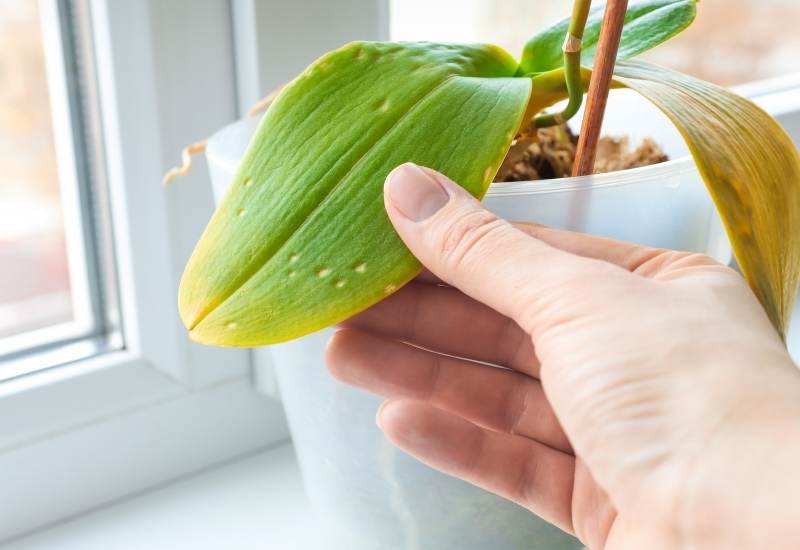
Orchids are a popular houseplant because they’re easy to grow and are visually stunning when placed correctly in your home. They can survive a variety of conditions and come in different colors.
Even though orchids are known for being easy to grow, you still might notice your orchid leaves turning yellow. It’s one of the most common problems that indoor gardeners face when they grow orchids inside of their home, and it can be frustrating.
In most cases, yellowing leaves is part of the natural life cycle of the orchid plant, and it doesn’t indicate that anything is wrong with your plants.
Eventually, the yellow leaves will drop away, and new leaves or a new flower spike appears. If your plant isn’t shedding old foliage, it could be one of these other common reasons for yellowing orchid leaves.
So, are you wondering why your orchid leaves turning yellow?
Over-watering is the most common cause of yellowing leaves on a orchids. The flooded roots are cut off from the air, due to which the roots cease to receive water and nutrients. As a result, the orchid’s leaves turn yellow, lose their elasticity, and the root system decreases. It is necessary to transplant the orchid into a fresh substrate and water a maximum of 1 time per week.
Yellowed and wrinkled leaves of an orchid can be a sign of illness, is a consequence of mistakes made in the process of leaving at home or a completely natural process, Let’s take a look at all of the reasons why are your orchid’s leaves turning yellow and what you can do to fix the problem.
The 9 Reasons For Orchid Leaves Turning Yellow
There are nine reasons why your orchid might have yellow leaves. Luckily, you can fix each of the reasons with a little TLC. Here is what you need to know.
1: The Natural Death Of Old Foliage On The Plant
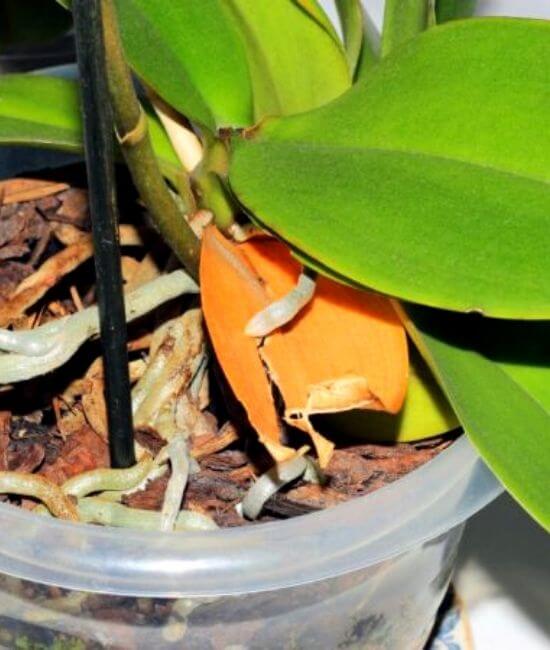
In most cases, orchids with yellowing leaves is part of the natural life cycle of this particular plant.
When the plant has to develop new leaves or a new flower spike, the lowermost set of leaves start to turn yellow. Over time, they die back and fall off of the plant.
The reason that orchids do this is because orchids prioritize new growth, so the plant believes the lower leaves are unnecessary.
It cuts off the water supply to the leaves, and over time, they’ll fall off of the plant.
How Do I Know The Yellowing Is Normal?
Of course, you don’t want to assume that the yellowing is normal only to realize you missed a significant problem.
If one or two leaves on the bottom of your orchid plant turn yellow, let it continue to do so. This is a classic sign of natural dieback.
Over time, the leaves will turn increasingly yellow and then wither off of the plant. The plant seals off these leaves from the rest of the plant, and they’ll drop off naturally.
Don’t remove them from the plant yourself!
Some people remove them because the look of yellow leaves is unsightly. Manually removing the leaves from your plant increases the risk of diseases.
It’s essentially like creating an open wound on your plant.
Instead, wait until the leaves look withered and yellow, which is a sign that the plant began the shedding process. Then, use a sharp, sterile knife to remove the leaf at the base.
Too Much Direct Sunlight
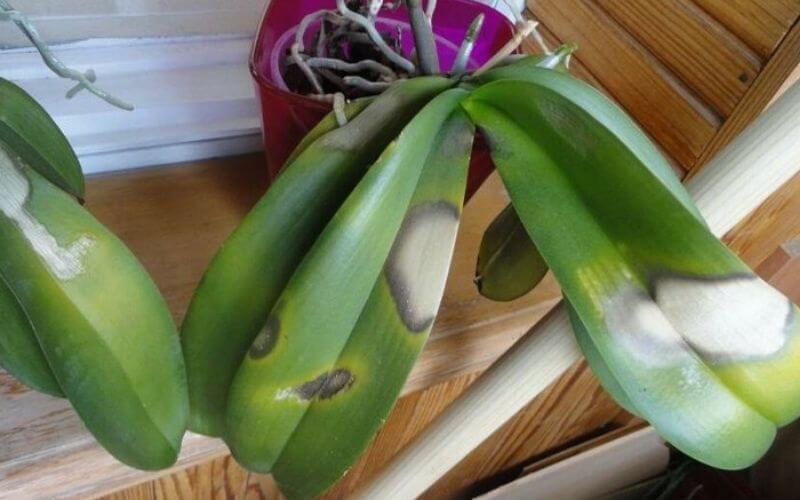
In nature, orchids are a tropical plant that typically grows in indirect sunlight under the canopy of trees.
They aren’t used to direct sunlight, so if they’re placed in a location that receives too much direct sunlight, the leaves can turn yellow.
All plants need light, but indirect sunlight is the preferred choice for orchids.
If too much direct sunlight is the problem, you’ll find yellowing leaves and fading. You might also find scorch marks, cracks in the leaves, and burnt leaf tips.
You need to take this into consideration when you select a location for your orchid plant.
How To Fix Too Much Sunlight
In your home, that would look like keeping your plant near north or east-facing windows through the summer when the sunlight is the strongest.
You can try south or east-facing windows in the winter because the sunlight is less intense, but make sure to a southern facing window in the summer. It’ll be way too strong for your orchids!
We can’t precisely control the location of our windows, though.
So, if you feel as if your plants receive too much direct sunlight, try adding a sheer curtain or moving it further away from the window, sitting on a stand instead.
Exposure To Low Or High Temperatures
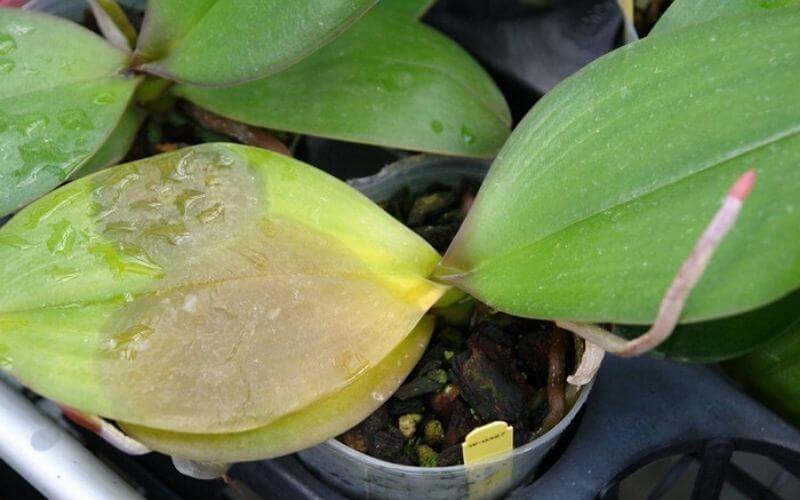
Orchids want to be kept at reasonable temperatures, in a range of 60-80℉.
For most homeowners, these are the average temperature inside of your home, so it works well.
Now, if your plants are subject to temperatures below 60℉ or above 80℉, the plant falls victim to excessive stress.
You might notice the progressive yellowing of leaves, as well as leaf drop. Temperature stress can also cause the browning or blackening of leaves or even plant death.
How To Fix Temperature Stress
Of all the problems your plant might face, exposure to the wrong temperatures is one of the easiest to fix.
Get a thermometer and double-check that the location you selected is staying within the acceptable range.
In some cases, windows can be subject to wide fluctuation in temperatures. In the summer with direct sunlight, your window sill might be like sitting in an oven, and if the temperatures are cold outside, the window might become chilly.
Overwatering Of Your Plant
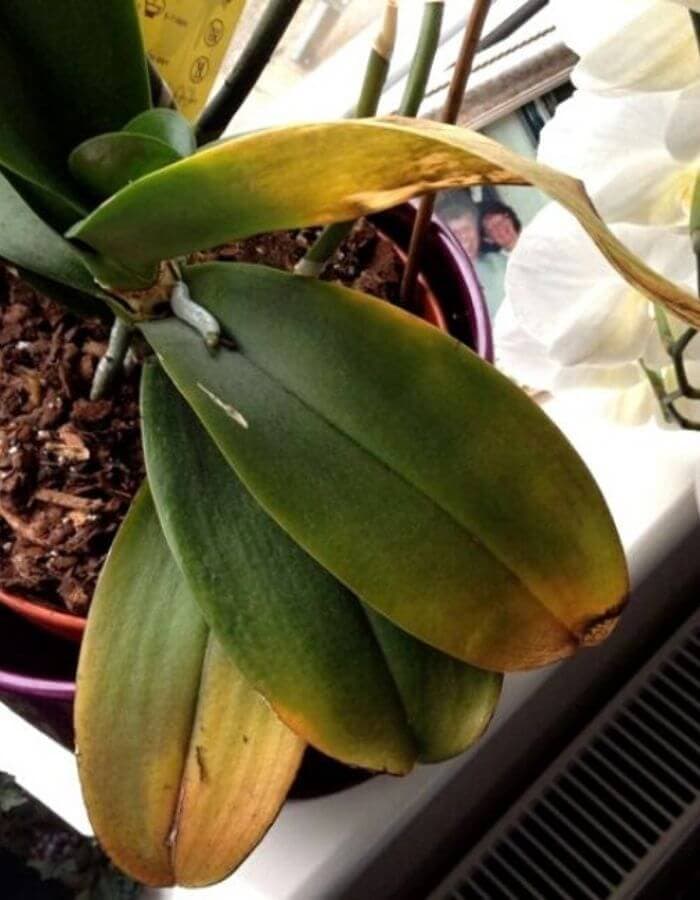
Too much water leads to the orchid leaves turning yellow, and it could even be the cause of root rot, which leads to the death of the roots. If you put too much water into the container, it prevents the plant from absorbing water and nutrients in the soil. As you can imagine, this can become a severe problem.
How To Fix Overwatering
First, don’t feel bad. People who have houseplants tend to overwater. You want to take care of your plant, and watering them is your most important task.
You just went a little overboard; it’s okay!
Despite what you might have read, orchids require a small amount of water. Before you water your plant, put your fingers into the potting medium.
Is It Dry?
If your answer is no, then wait another day (or two) before watering your plant. If the answer is yes, feel free to give your plant some – not too much – water.
Despite what your plant nurturing instincts might tell you, it’s always better to stay on the side of underwatering rather than overwatering. Orchids tolerate these conditions better than too much water.
A Sudden Change In The Environment
When you change the location or environment of a plant, it can cause your plant to feel stress, leading to the dropping of the leaves or blooms.
Yellowing leaves are a more severe sign of stress in plants. This stress can take place when you first bring your plant home from the store or if you move your plant from one room to another. It could happen if you need to move houses or anything.
How To Fix It
If you just brought your orchid home from the store, don’t worry if the leaves start to yellow. You can’t do much.
Make sure that you pick a great location for your brand new plant, and it will gradually work itself out.
It can be hard to prevent this type of issue, and the only thing that you can do is provide the right climate.
You would hope that stores would take care to reduce stress on plants, but we know that’s not always the case.
Too Much Fertilizer
Just like overwatering, it’s easy to add too much fertilizer. When you add too much fertilizer, it leads to extra nutrients in the soil, such as calcium, manganese, copper, or zinc.
While the plants do need access to extra nutrients, the levels can become excessive, and that prevents your orchids from taking iron.
A sign of iron deficiency in orchids is yellowing of the leaves. It’s a condition called chlorosis.
You want your plant to be healthy, and you probably don’t realize that adding too much can be just as problematic, if not more, as not adding enough.
How To Fix Excess Fertilizer
Once you’ve given your plants too much fertilizer, you can’t take it back. Instead, spend some time learning about the proper way to feed your plants.
Orchids are light feeders, so infrequent feedings are ideal, and you do need to dilute.
You’ll want to cut the strength by ¼ to ½ when compared to the fertilizer that you use with other houseplants. Another option is to find an orchid specific fertilizer and follow the directions carefully.
You should also make sure you’re not always watering with a water-soluble fertilizer. It’s best to alternate, which gives time to drain out nutrient salts in the potting soil.
When you buy your orchids, chances are they’re already in full bloom. So that means you don’t need to fertilize.
Remember not to feed while in full bloom. When the blossoms drop, start fertilizing to encourage the growth of your plant and new flower development.
A Nutrient Deficiency
If you don’t give your plants any fertilizer, a nutrient deficiency could cause yellowing as well.
You might not realize that you need to fertilize your plants, assuming that the potting medium has enough nutrients for your plant.
While it does, there isn’t enough to last forever.
When the nutrient reserves run out, your plant will start to sign shows of nutrient deficiency unless you apply a feeding.
Most commonly, orchids have deficiencies in manganese, zinc, iron, and nitrogen. All of these are required for proper growth and require fertilizer.
How To Fix A Nutrient Deficiency
This problem is easy to find! All you need to do is start applying a fertilizer every other week or whatever the directions on the fertilizer you bought indicate.
Exposure To Hard Water Or Chemicals
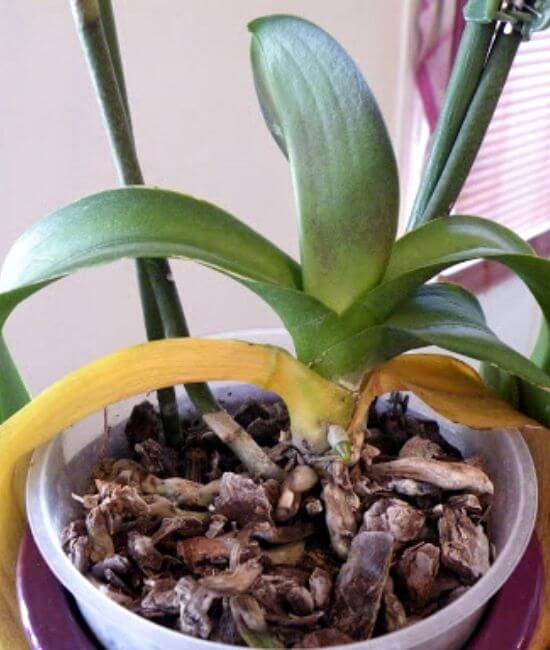
One problem that these plants don’t always handle well is the type of tap water that you use to water and feed your plants.
Some areas have hard water or water excessively treated with chlorine. In these cases, your orchid plants might struggle to process these chemicals, leading to yellowing tips.
Hard water has high levels of calcium and magnesium, which can harm the plant’s ability to absorb essential micronutrients. That can cause nutrient deficiencies and leaf problems.
How To Fix Water Problems
If you can’t seem to figure out why your orchid leaves are turning yellow, you can call your local water inspection and ask for copies of the water testing results.
That can tell you all of the chemicals detected in the most recent test.
If that indicates there is a problem, you have three options: use rainwater, purchase a house filtering system, or buy filtered water for your plants. Using rainwater is the cheapest choice, but it is illegal in some states, so check your state laws first.
An Infection
Last but not least, your plants could have an infection or disease that is causing the yellowing. Typically, diseases are more likely to cause yellow spots and patches on the leaves rather than the general yellowing of an entire leaf.
Here Are Three Common Diseases And Infections That Orchids Encounter.
Root Rot
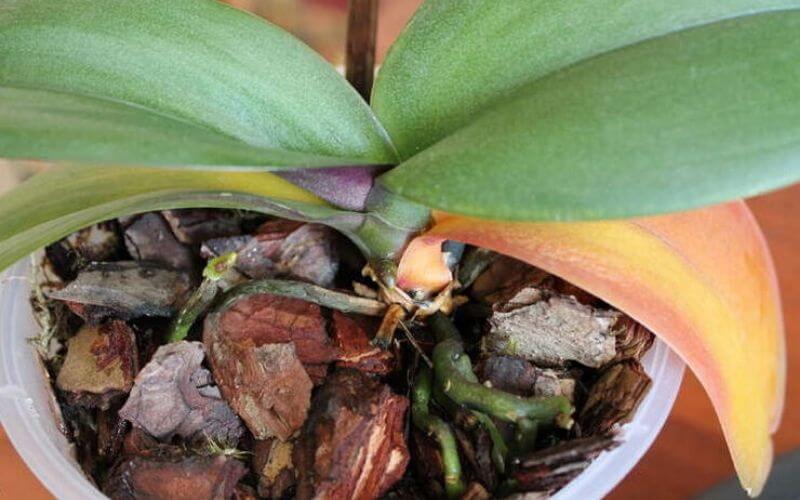
If you encounter any diseases, chances are it’ll be root rot because it is most common.
Root rot is a fungal infection of the roots, which typically happens if you overwater, use a pot without drainage holes, or poorly draining medium.
The primary issue with root rot is that it will take over fast and kill your plant quickly. So, if you notice yellowing leaves, check the roots.
You’ll know your plant has root rot if the roots are brown or black, soft, and fragile.
If the plant has some healthy roots, it’s possible to save the plant, but you need to use sharp, sterile scissors to remove all rotten roots.
Fungal Leaf Spot
This infection is known for causing yellow areas that start on the bottom and underside of the leaves.
When left untreated, fungal leaf spot will cause the spots to become larger, turning to brown or black.
For mild infections, you can spray or wipe the leaves with a fungicide. It’s typically advised to remove all infected leaves and then treat the healthy leaves.
Bacterial Brown Spot
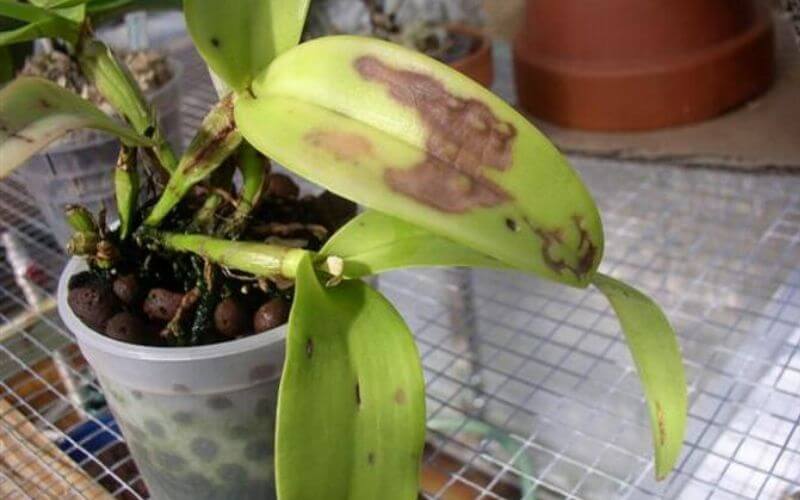
If you notice wet-looking yellow or brown spots on the leaves, chances are you have the bacterial brown spot.
If you have your orchid in a hot and humid area, this is more common. As it gets worse, it leads to the generalized yellowing of the leaves, which is a sign of the stress the plant is under.
The best treatment plan is to remove all infected parts of the leaves or the entire leaves. Always use sterile scissors!
After removal, you can try a broad spectrum of bacterial spray or fungicide to prevent the fungus spores from infecting more of the plant.
Finding The Reason For The Yellowing
When you notice your orchid leaves turning yellow, the first step is to go through all of these nine reasons and determine what the problem is.
It could be the natural lifecycle, or your plant could be under stress.
After you determine the reason for the yellowing, you can take appropriate steps and measures to fix the problem and ensure that it doesn’t return in the future.

Written By
Bethany Hayes
Bethany is a suburban homesteader, growing over half of the vegetables, fruit, and herbs that her family of six needs each year. She raises chickens and homeschools her children. When she isn’t spending time tending to her garden, you can find her reading, crocheting, and canning.

Thanks for such a great article. I hope my orchid will get better. I’m so sad looking at her leaves turning yellow
My husband bought it for me three months ago, I didn’t know much about them and put it in dirt… found out it doesn’t grow that way , took out rinsed plant, purchased orchid based soil. First flowers dropped off, then leaves started yellowing at the root and then to the end and fall out, now I’m down to two leaves, help!!!
If the leaves are yellow and you notice a foul smell, it could be a bacterial infection. To prevent dropping orchid leaves due to disease, remove affected leaves as soon as possible, using a sterile knife or razor blade. When cutting on an orchid we always recommend the use of a clean tool (to avoid the possibility of spreading virus from one orchid to another) and applying cinnamon (the common household spice) to the cut area as a preventative measure against any opportunistic infection
My orchid grow some strange think on the bottom.It’s not a flower, not a new leave, it’s like miniature adult plant.Maybe it’s the baby. What should I do with this newgrow?Thanks.
Orchids sometimes sprout baby plants, or keikis, from their flower stems. Literally translated, “keiki” is Hawaiian for “the little one” — and that’s just what keikis are. You can remove these plantlets and pot it up to grow more orchids. To remove a keiki, simply cut it off with a sharp, sterile blade. To prevent more keikis from forming, you may want to cut back the mother orchid’s spikes after they’re done blooming.
Hi have one lovely flower and five healthy buds ready to open. Sadly three quite sizeable Yellow leaves and one has just dropped off. Can you help please?
If you discover the yellowing leaf is located on the bottom of the plant, don’t worry. This is a natural process of the plant to discard the mature leaf in order to produce a new leaf.
I got my orchid on my birthday, 4/17. I have watered it three times since then, and only recently read about soaking them in a bath for you to 15 mins, I was only splashing enough water to make the roots turn green and barely make the bark damp. I thought I was underwatering it, but now I see some white spots like mold.growing on the roots through the clear plastic container, and all of a sudden my blooms dried up and fell off, the spike is turning whitish yellow with pink node s where the flowers were…is my orchid dying? Even the leaves are drooping and curling up, with some spots thinning out to yellow patch. Can I save my present still? What can I do? Everything I read is conflicting. Is it possible to underwater and overwater at the same time? I keep it on my.kitxhen table, east facing and shaded but not dark. I have blinds.on that.window.that.I open during the day, but it is near my.kitchen door which I open to let fresh air in to the kitchen and living room.
I think your Orchid isn’t dead; it’s resting, in simple at their dormant time, you will notice blooms drop from the stem, and the stem may shrivel and turn gray or brown. The orchid’s leaves gradually lose their bright green gloss and upright stance, turning dull and flattening out around the orchid’s base.
I have four orchids of various ages and types. Their leaves are generally green and healthy looking, with what looks like natural die off. They are in a north facing window with good light and stream when washing dishes. The issues they have are infrequent or no blooms, and wrinkled air roots. Your suggestions are very appreciated.
Thank you, Sigrid
The reason why the roots on your plant are wrinkley is because it was exposed to the relatively drier air in your room compared to the more humid air of the tropics. Put the root in the pot and you should be fine.
I also recommend that you repot your plant in large grade wood chips rather than keep it growing in the moss. Sphagnum keeps the roots too wet for too long in the case of Phalaenopsis and may rot out quite a few of the roots on your plant. Again when you repot, find the dead roots and remove them. Living ones are green or whitish green, with green or olive tips. Dead ones are brown, black, or beige.
Thank you!
So it’s alright to redirect roots that are growing horizontally back into the pot? I have two roots that are growing parallel to the ground and shooting out from the pot sideways, and one is several inches long at this point. Will it damage them if I bend them so the tips are in the potting medium?
I had a yellow leaf that was pulling away from the stem and almost half off, (so before I read how your NOT supposed to pull them) I pulled it. :-/ Now there is another yellow leaf doing the same thing. Both are located in the middle of the stem. What do I need to do to stop it? My orchid is in the middle of it blooming. I have this plant about 5 years and it’s done great. I hope I did screw it up. Any suggestions how to save it?
Thanks
AC
I had yellow leaf mid level that I pulled off before I read NOT to pull, but to cut with something sterile. So now I have tow other yellow leaves. I’m sick, I’ve had this orchid 5 years. So now I have 3 yellow leaves, but the 2 bottom and 3 top leaves still look good. I hope that’s a good sign. Is there anything i can do to save my orchid?
If you discover the yellowing leaf is located on the bottom of the plant, don’t worry. This is a natural process of the plant to discard the mature leaf in order to produce a new leaf.
It not at the bottom it’s in the middle of the plant. Where I pulled off the dead leaf. It’s now caused the 2 leaves above where I pulled the leaf to turn yell and die. The middle is now looking like it’s drying up. The flowers r still in bloom, the 3 leaves on the top are still green and the bottom 2 leaves are green. It’s all right in the middle of the plant.
It not at the bottom it’s in the middle of the plant. Where I pulled off the dead leaf. It’s now caused the 2 leaves above where I pulled the leaf to turn yell and die. The middle is now looking like it’s drying up. The flowers r still in bloom, the 3 leaves on the top are still green and the bottom 2 leaves are green. It’s all right in the middle of the plant.
My orchid’s air roots are so abundant. Is this normal? The lower ones have a smaller diameter, have a wrinkled appearance, and are not stiff. The ones at the level of the second to last flower spike are a little larger and only slightly wrinkled. They are also more silver than gray. Then, the ones that are at the level of the last flower spike are fat like a worm, super glossy, silver, and have no wrinkles.
What does it all mean?
the roots are hanging outside the plant and stringing all over , two leaves are yellow at the bottom of the plant. one fell off
If you discover the yellowing leaf is located on the bottom of the plant, don’t worry. This is a natural process of the plant to discard the mature leaf in order to produce a new leaf.
My orchid (phaleonopsis) has one new leaf at the bottom and it has turned yellow. Is this normal?
Yes, as the natural part of the orchid life cycle, an older leaf at the bottom will turn yellow and begin to wither away.
Im confused wheter to water or not.
I live in Brisbane where its hot most of the year.
My leaves are flopping, yellowing and splitting and dropping off. Ive lost at least 6 leaves, an entire nodules has lost its leaves, but it has two large flowering stems which were in bloom when I received the plant.
Obviously my plant is getting too much light so Ill put it in the shade but when do I water and how much?
I have my plant in a pot of orchid mix.
I was given my orchid as a present, it had beautiful white flowers, they eventually died and naturally dropped off. New shoots at the bark appeared but only grew a few inches tall. Then the leaves at the bottom started turning yellow and naturally dropping off. I now have 4 green leaves left on the original stalks, but I do have a couple of tiny new shoots on those original stalks. Now however, one of the leaves on the new shoots is turning yellow. I rarely water, spray occasionally with orchid feed, and I put it in my bathroom thinking the steam will help. I’m hoping the orchid will look better as at the moment it looks quite bare. I’ve moved it to sit on the windowsill, fingers crossed that helps a bit. Any advice or recommendations would be really appreciated.
All my orchid leave turns yellow from the bottom and leave look watery what should I do plz I only have three greens leave
Healthy orchid leaves are strong and hold their shape. If your leaves are floppy, your plant might be developing root rot. If you suspect your orchid might have root rot, stop watering immediately.
My orchid leaves are turning yellow from the top, with a dark center. Help!
I love the way you write. It’s a if you are talking about the orchids as if they are our children. This has been so helpful and reassuring about how we should care for our plants. Thank you!
Do you cut the stalk off that flowers were on. The stalk looks dead .Thanks
When the last flower fades, you can leave the spike (stem) on and it will still continue flowering but the stem gets very ungainly and the flowers get smaller.
My son gave me an orchid for Mother’s Day, I love it and I love all plants. I’ve never had an orchid before so I appreciate all of your tips and suggestions. THANK YOU.
Success with caring for orchids comes from consistency, not owner expertise. “Orchids need a few things to stay consistent, so once you’ve established the best conditions for your new plant, you’ll be able to enjoy it year after year. They may seem like advanced level plant care, but they are a low maintenance plant if you keep these few things in mind.
1: Not to water your orchid more than once a week.
2: Place a water-filled saucer or tray of pebbles beneath plants, mist plants daily, or use a humidifier.
3: When growing an orchid indoors, it is recommended that it receive six hours of indirect sunlight a day to stay healthy, east-facing windows are ideal.
4: Instead of soil, use a potting mix made especially for orchids
Thanks so much for your helpful information. I love my first 2 phals & they are my babies.
I found your site because suddenly my amazing first miniature finished 3 months of blooming beauty.
I just found 2 yellow leaves on bottom.
I pulled them & they easily came off.
I panicked.
Thanks so much for your valuable info, wish me luck.
My air roots have shriveled & dried out. I heard this was not good and the orchard needed to be watered more frequently. Now I have a bottom leaf that has turned yellow. Any idea what is wrong?
If the orchid is presenting signs that make you think that it is underwatered, yet after watering it the roots still remain gray or white, this is a sign that the problem could be root rot rather than underwatering.
If you think your orchid is overwatered, stop watering it immediately ang move it to a spot where it can get good air circulation. Do not water it again until you are sure that the potting medium has dried out.
Remove all the affected roots as well as any air roots that have shriveled or dried out, until only the healthy roots remain. Do not worry about the roots that you removed; the plant will be more than capable of growing new air roots once it has recovered fully.
I’ve read that it helps to take the entire plant out of the pot and clean out all
the debris between the roots, leaving the roots intact, then to repot it using new Orchid potting mix.
Do you agree ?
If your orchid is fighting root rot, you may want to make the hydrogen peroxide and water solution in a bowl and fully submerge your plant’s roots into the mixture. This is to make sure the entire infection is treated before you repot your plant.
My orchid has been beautiful and healthy for a long time BUT I noticed lately her dark green leaves are turning pale but not yellow…what could be wrong
I see! If your orchid’s dark green leaves are turning pale but not yellow, it could be a sign of a few different issues.
One possibility is that your orchid is getting too much direct light. Orchids prefer bright, indirect light, so make sure it’s not getting too much sun. If it is, try moving it to a slightly shadier spot.
Another possibility is that your orchid is experiencing a nutrient deficiency. Orchids have specific nutritional needs, so make sure you’re using a fertilizer that is formulated for orchids and following the instructions carefully.
Overwatering can also cause orchid leaves to turn pale. Make sure you’re allowing the potting mix to dry out slightly between waterings.
Low humidity is another common issue for orchids, and can cause the leaves to turn pale. Consider using a humidifier or placing a tray of water near your orchid to increase the humidity around it.
Lastly, temperature stress can also cause orchid leaves to turn pale. Make sure your orchid is not exposed to extreme temperatures.
I hope this helps you determine what’s going on with your orchid. If you have any more questions or concerns, feel free to ask!
Thanks so very much for a very well though out and written article on yellowing in orchids. It’s been so very helpful.
I just got some new orchids from online. 4 of them look wonderful the other looks a little sick. Its leaves I think got folded a bit in transport and are pale greenish yellow. I know it isn’t over watered because it had just the roots and no medium. Could it be that the leave are just damaged from traveling. I looks a little sad like it needs a drink. I potted it in bark in a pot full of holes. I don’t quite know what to think. Suggestions?
It sounds like your new orchid may indeed be experiencing stress due to transportation. Here are some suggestions to help it recover:
Light and Location: Ensure the orchid is placed in a location with bright, indirect light. Direct sunlight can be too harsh, especially for a stressed plant.
Watering: Since you mentioned it’s potted in bark and the pot has good drainage, water the orchid when the bark starts to feel dry. Over-watering can be detrimental, so it’s better to err on the side of caution. When you do water, ensure the water runs through the pot and drains out completely.
Humidity and Temperature: Orchids thrive in humid environments. You can increase humidity around the plant by placing a water tray with pebbles under the pot, ensuring the pot is not sitting in water. Also, maintain a stable temperature, avoiding cold drafts or extreme heat.
Leaf Care: If the leaves are just bent and not broken, they might recover on their own. Avoid trying to straighten them forcefully. If they are yellow, observe if the condition spreads. Yellow leaves can also be a sign of other stress factors like over-watering or lack of nutrients.
Feeding: Once the orchid appears to be settling in (after a few weeks), you can start a regular feeding schedule with a balanced orchid fertilizer.
Patience and Observation: Sometimes, all a plant needs is a bit of time to adapt to its new environment. Keep an eye on your orchid, looking for signs of new growth or further decline, which can indicate if the care you’re providing is working or if adjustments are needed.
Remember, each orchid is unique and might react differently to its environment and care routine. If the condition of your orchid continues to decline, it might be helpful to consult with a local nursery or an orchid specialist for more tailored advice.